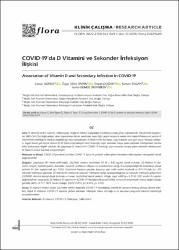| dc.contributor.author | Gürsoy, Canan | |
| dc.contributor.author | Oral Tapan, Özge | |
| dc.contributor.author | Doğan, Emrah | |
| dc.contributor.author | Togan, Turhan | |
| dc.contributor.author | Gümüş Demirbilek, Semra | |
| dc.date.accessioned | 2023-03-06T07:42:40Z | |
| dc.date.available | 2023-03-06T07:42:40Z | |
| dc.date.issued | 2023 | en_US |
| dc.identifier.citation | Gürsoy C, Oral Tapan Ö, Doğan E, Togan T, Gümüş Demirbilek S. COVID-19’da D vitamini ve sekonder infeksiyon ilişkisi. FLORA
2022;27(4):562-9. | en_US |
| dc.identifier.issn | 1300-932X | |
| dc.identifier.uri | http://floradergisi.org/managete/fu_folder/2022-04/2022-27-04-562-569.pdf | |
| dc.identifier.uri | https://hdl.handle.net/20.500.12809/10567 | |
| dc.description.abstract | Giriş: D vitamini sitokin salınımı, inflamasyon, doğal ve edinsel bağışıklığın modülasyonunda görev yapmaktadır. Pandeminin başların- da SARS-CoV-2’ye bağlı gelişen akut respiratuvar distres sendromu veya diğer organ hasarına neden olan hiperinflamatuvar yanıtın D vitamininin yeterliliği ile modüle edilebileceği sıkça tartışılmıştır. D vitamininin; mortalite, yoğun bakım yatış gün sayısı, hastalık ciddiye-ti, organ hasarı gibi birçok durum ile de ilişkisi araştırılmıştır fakat hastalığın seyri sırasında ortaya çıkan sekonder infeksiyonlar üzerine etkisi konusunda bilgiler sınırlıdır. Bu çalışmada D vitamininin COVID-19 hastalığı seyri sırasında ortaya çıkan sekonder infeksiyonlar ile ilişkisini ortaya koymak amaçlanmıştır.
Materyal ve Metod: COVID-19 pandemi servisine COVID-19 tanısı ile yatarak tedavi gören hastaların tıbbi kayıtları retrospektif olarak değerlendirildi.
Bulgular: Çalışmaya 181 hasta dahil edildi. 25(OH)D vitamini ortalaması 18.76 ± 9.82 ng/mL olarak bulundu. 25-hidroksi D vita-minin cinsiyet, hastalık şiddeti, mortalite, mekanik ventilasyon ihtiyacı ve semptomların varlığı ile karşılaştırıldığında istatistiksel olarak anlamlı bir fark saptanmadı (p> 0.05). Hastaların hastane yatışları boyunca olan tıbbi verileri incelendi ve %14.9’unda (n= 27) sekonder infeksiyon saptandı. 25-hidroksi D vitamini ile sekonder infeksiyon varlığı karşılaştırıldığında ise sekonder infeksiyon gelişenlerin 25(OH)D vitamini düzeyi düşük bulundu ve bunun istatistiksel olarak anlamlı olduğu tespit edildi (p= 0.016). ROC analizi ile yapılan değerlendirme sonucunda 25-hidroksi D vitamininin COVID-19 hastalarında pozitif kültür sonucunu öngörmede tanısal değeri olduğu görüldü (AUC= 0.771, %95 Güven aralığı= 0.612-0.810, p= 0.003, p< 0.05).
Sonuç: D vitamini immün sistem üzerindeki etkileri nedeniyle COVID-19 hastalığında önemli bir tartışma konusu olmaya devam ederken, düşük D vitaminin COVID-19 seyrinde gelişen sekonder infeksiyon riskini arttırdığı ve bu durumun prognoza etkisinin olabileceği unutulmamalıdır. | en_US |
| dc.description.abstract | Introduction: Vitamin D plays a role in the modulation of cytokine release, inflammation, innate and adaptive immunity. It has been frequently discussed that the hyperinflammatory response that causes acute respiratory distress syndrome or other organ damage due to SARS-CoV-2 at the beginning of the pandemic can be modulated by the adequacy of vitamin D. The relationship of vitamin D with many conditions such as mortality, number of intensive care unit stays, disease severity, and organ damage has been investigated, but the information on its effect on secondary infections that occur during the course of the disease is limited. In this study, it was aimed to reveal the relationship of vitamin D with secondary infections that occur during the course of COVID-19 disease.
Materials and Methods: Medical records of patients hospitalized in the COVID-19 pandemic service with the diagnosis of COVID-19 were evaluated retrospectively.
Results: One hundred eighty-one patients were included in the study. The mean of 25(OH) vitamin D was found to be 18.76 +/- 9.82 ng/mL. When 25-hydroxy vitamin D was compared with gender, disease severity, mortality, need for mechanical ventilation and presence of symptoms, no statistically significant difference was found (p> 0.05). The medical data of the patients during their hospitalization were analyzed and secondary infection was detected in 14.9% (n= 27). When 25-hydroxy vitamin D and the presence of secondary infection were compared, the 25(OH)D vitamin level of those with secondary infection was found to be low and this was found to be statistically significant (p= 0.016). As a result of the evaluation made by ROC analysis, 25-hydroxy vitamin D was found to have a diagnostic value in predicting positive culture results in COVID-19 patients (AUC= 0.771, 95% Confidence Interval= 0.612-0.810, p= 0.003, p< 0.05).
Conclusion: While vitamin D continues to be an important topic of discussion in COVID-19 disease due to its effects on the immune system, it should not be forgotten that low vitamin D increases the risk of secondary infection developing in the course of COVID-19 and this may have an impact on prognosis. | en_US |
| dc.item-language.iso | tur | en_US |
| dc.publisher | BILIMSEL TIP YAYINEVI | en_US |
| dc.relation.isversionof | 10.5578/flora.20229605 | en_US |
| dc.item-rights | info:eu-repo/semantics/openAccess | en_US |
| dc.subject | D vitamini | en_US |
| dc.subject | COVID-19 | en_US |
| dc.subject | İnfeksiyon | en_US |
| dc.subject | SARS-CoV-2 | en_US |
| dc.subject | Vitamin D | en_US |
| dc.subject | Infection | en_US |
| dc.title | COVID-19’da D Vitamini ve Sekonder İnfeksiyon İlişkisi | en_US |
| dc.item-title.alternative | Association of Vitamin D and Secondary Infection in COVID-19 | en_US |
| dc.item-type | article | en_US |
| dc.contributor.department | MÜ, Tıp Fakültesi, Dahili Tıp Bilimleri Bölümü | en_US |
| dc.contributor.authorID | 0000-0003-0658-9138 | en_US |
| dc.contributor.authorID | 0000-0003-1499-3747 | en_US |
| dc.contributor.authorID | 0000-0002-9446-2294 | en_US |
| dc.contributor.authorID | 0000-0002-5490-8888 | en_US |
| dc.contributor.authorID | 0000-0001-7721-4582 | en_US |
| dc.contributor.institutionauthor | Gursoy, Canan | |
| dc.contributor.institutionauthor | Oral Tapan, Özge | |
| dc.contributor.institutionauthor | Doğan, Emrah | |
| dc.contributor.institutionauthor | Togan, Turhan | |
| dc.contributor.institutionauthor | Gümüş Demirbilek, Semra | |
| dc.identifier.volume | 27 | en_US |
| dc.identifier.issue | 4 | en_US |
| dc.identifier.startpage | 562 | en_US |
| dc.identifier.endpage | 569 | en_US |
| dc.relation.journal | FLORA INFEKSIYON HASTALIKLARI VE KLINIK MIKROBIYOLOJI DERGISI | en_US |
| dc.relation.publicationcategory | Makale - Uluslararası Hakemli Dergi - Kurum Öğretim Elemanı | en_US |


















